OTT Advertising Guide: Key Definitions & Marketing Examples [2023]


Streaming video is an increasingly popular and effective way of reaching modern viewers and is the ideal choice for brands that want to engage potential customers in the discovery phase of the consumer journey.
Streaming video advertising provides an effective connection between a brand and an interested consumer through the trinity of sight, sound, and motion. Streaming also allows brands to optimize their ads with modern machine learning and future proof them with first party data.
Today, ad-supported services within the video landscape include some of the most recognizable names on the market, including Hulu, Tubi, Paramount+, Peacock, and Discovery+ just to name a few.
As marketers, we know that video has been notoriously hard to measure compared to traditional display and search ads. But those days are behind us now.
Here’s a breakdown of OTT advertising and how brands are buying, targeting, and measuring the success of their OTT video campaigns. In the following blog article, we will discuss
OTT (over-the-top) advertising is advertising delivered directly to viewers over the internet through streaming video services or devices. The channel allows media buyers to target precise audience segments and provides the advanced measurement capabilities that digital marketers have come to expect.
The term “over-the-top” comes from the ability to bypass traditional TV providers that control media distribution, helping advertisers reach their audiences directly. Going over the top allows media companies (and advertisers) freedom of movement without pre-planned broadcast schedules or geographic limitations.
While we often see marketers use OTT and CTV interchangeably, the two concepts are not the same. However, they are closely related. OTT is a method of ad delivery that can take place on a number of devices. A connected TV refers to an internet-connected television that supports OTT ads.
You may see OTT ads served on Connected TVs, but other devices can serve OTT ads as well. For example, you may see an OTT ad while watching Hulu on your mobile phone – in this case, there’s no television required.
Using OTT in advertising is crucial for several reasons. It helps target ads accurately, adapts to privacy changes, makes ads more relevant and engaging, and ensures brand safety while offering top-tier inventory without fraud.
One of the powerful components of OTT is that it offers multiple layers of audience targeting. Depending on the platform and your approach to buying OTT, you can target based on the provider’s audience data, or in some cases, with layering your own customer data.
Most of the larger OTT platforms allow you to target against:
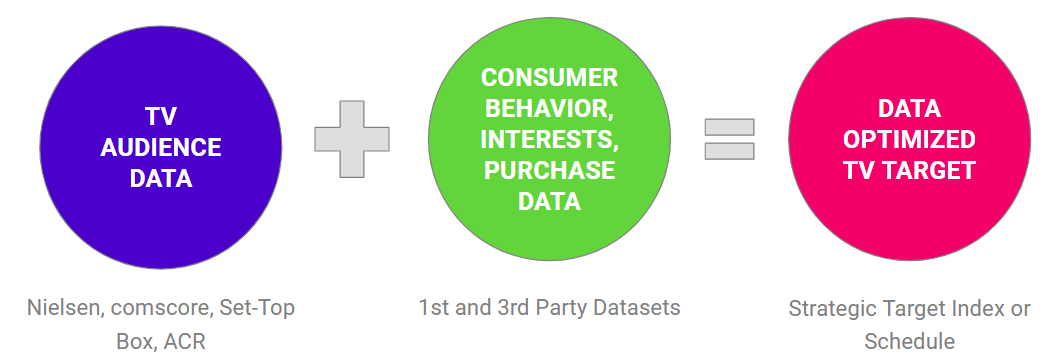
Additionally, if you take a cross-channel approach to OTT, you can target and retarget the same audience across multiple channels and screens.
For example, with the right OTT strategy, you could reach your audience on their TV screens, then retargeted across OTT, audio, display, and more, creating a truly connected cross-channel ecosystem that moves the needle for your brand.
With major data privacy-focused changes expected to heavily impact the ‘how’ of performance marketing targeting and measurement, many advertisers are seeking fresh solutions that allow them to shift some of their marketing dollars into areas that will continue to be highly targetable and measurable.
In this moment of privacy, the TV screen is becoming one of the most targetable devices in an advertiser’s toolkit. Because the TV screen never had cookies or IDFA to begin with, their deprecation doesn’t affect TV screen targeting in the same way.
“Data is and will continue to be a big piece of the conversation going forward. With this ever-evolving space and with the way data is changing (and as we see cookies going away) first-party publisher data will be more important and deterministic data overall. Specifically in programmatic exchanges.”
– Kayla Yee, Account Executive, Sling TV at Dish Media
OTT advertising boosts engagement by tailoring ads to individual viewer preferences through data analysis. It offers precise targeting based on demographics and interests, ensuring ads reach the right audience. Interactive elements and varied ad formats make ads more engaging and encourage viewer interaction. Timing ads during relevant content enhances engagement, and frequency capping prevents ad fatigue. Detailed performance metrics help advertisers refine campaigns for better engagement results.
For ensuring brand safety in OTT advertising, it’s crucial to employ precision in targeting and real-time reporting. Contextual targeting and transparent reporting capabilities play a pivotal role. By combining contextual data and categories, advertisers can establish finely tuned targeting criteria for their ad placements. This approach helps prevent the display of ads on channels deemed inappropriate for specific audiences, thereby avoiding association with “fake content” or unsuitable content.
Build and supplement base campaigns with focused, complementary strategies: incremental reach, manage frequency, target competitors, and focus on lapsed customers. Over the top video is a channel that can meet a wide variety of marketing and sales initiatives, thanks to growing capabilities in scaling, measuring, and data-driven targeting.
Many places talk about over the top in just the context of upper-funnel awareness or oversimplify OTT goals as being the same as TV goals. You can leverage OTT video as a full-funnel performance channel that does more than just build your brand; it can engage and move customers through the entire funnel.
The landscape of advertising has evolved significantly, with OTT ad campaigns becoming highly measurable and optimizable. Unlike traditional TV advertising, where gauging effectiveness was challenging, OTT platforms provide precise metrics. Advertisers can track viewer engagement, click-through rates, and even demographic insights in real-time, allowing for data-driven decisions. This wealth of data empowers advertisers to optimize future campaigns, refining targeting, content, and ad formats for maximum impact.
OTT can be a full-funnel performance driver. What makes Tinuiti unique is that our approach focuses on the right fit for each brand. This can include traditional goals of reach and frequency. Or it can mean digital measurement, programmatic, or sponsorship — it all depends on the brand’s needs.
Brands with advanced digital strategies are adopting OTT advertising as part of their performance mix because the future of TV is becoming more digital and data-driven.
Streaming video stats show that viewing has gone mainstream in recent years, especially for younger audiences, whose viewing habits have shifted from cable viewing to streaming services and OTT apps such as Netflix, Hulu, Roku, Crackle, Plex, PlutoTV, Vimeo, Vevo, and more.
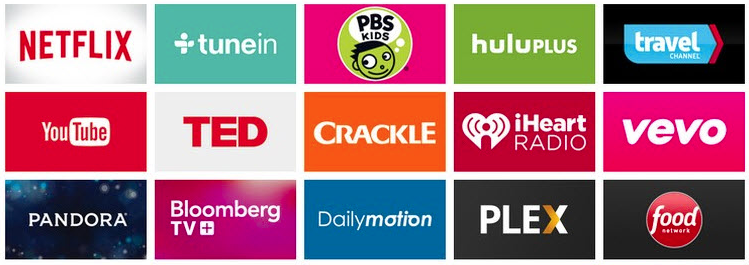
According to the most recent data, 83 percent of consumers in the United States were using a subscription video-on-demand service in 2023, an increase of over 10 percentage points in five years.
Where viewership consolidates, so does ad spending. Between October 2021 and January 2022, U.S. OTT ad spend reached $4 billion and accounted for 13% of the $32 billion total digital ad spending.
Beyond growing OTT video viewership, over-the-top marketing platforms are becoming more sophisticated, giving brands full-funnel targeting and attribution capabilities that weren’t available just a few short years ago.
At Tinuiti, we see OTT video as being ripe for two kinds of brands: TV advertisers that are looking to recapture some of the impressions and reach that are no longer available through traditional channels, and challenger brands that don’t have direct broadcast budgets but can play in the TV space for the first time through OTT. Consumers are moving to OTT channels and Connected TV. So brands need to start from the perspective that it can work; they just need to understand how to use it to their advantage.
When it comes to making an OTT advertising plan, it’s usually best to rely on experts who know the ropes. But if you want a quick peek into how it’s done, here’s a simple step-by-step guide:
Over the top video advertisements can display across a myriad of devices (such as Roku or connected TV) and streaming services (such as OTT apps). Basically, if the device streams video over the internet, it can support OTT ads. Here are a few of the most popular OTT delivery channels:
However, OTT ads don’t just “appear” on any of these devices — content delivery is facilitated through a number of OTT distribution channels.
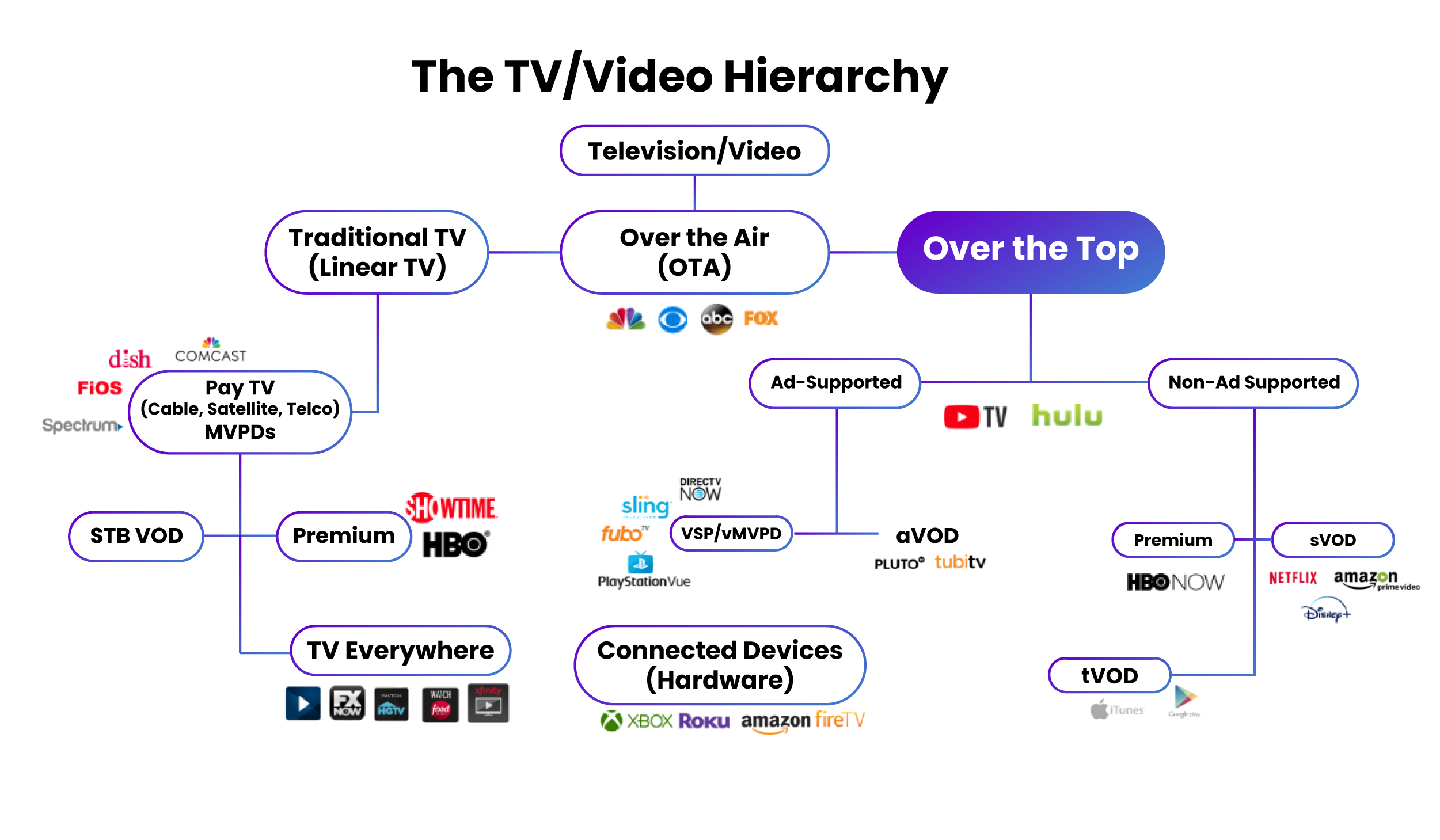
Keep in mind that OTT channels deliver ads as well as content directly to customers. Viewers can access a wide array of on-demand movies, shows, and original content on platforms like Netflix and Amazon Prime. These channels also insert targeted ads, ensuring relevance to individual viewers through data-driven insights. This shift in content delivery and advertising caters to modern consumer preferences and challenges traditional TV models.
But here’s where things can get rather complicated. The streaming video landscape is complex and fragmented among devices, channels, platforms, and publishers.
It’s important to remember that the term ‘OTT’ is not a catch-all for the industry. Those who are super familiar with the concept are likely to use terms like AVOD/SVOD. So if you want to uplevel your knowledge, it’s helpful to know what these terms mean and which services fall into each category. Let’s dive in.
Subscription video on demand (SVOD) streaming services require viewers to purchase a subscription. Some SVOD providers are entirely ad-free, but major platforms like Disney+ are beginning to offer ad-supported services at discount rates to subscribers. Netflix, Hulu, and Amazon Prime Video are three well-known SVOD services.
AVOD streaming services provide free content to consumers and are supported entirely by ads. Viewers typically are shown ads before, during, and after watching content. Crackle, Tubi, and Vudu are three of the most popular AVOD services among consumers today.
Similar to a traditional cable package, vMVPDs are streaming services that offer subscribers a small number of live TV channels delivered over the internet. For example, YouTube TV subscribers can stream live sports from a local station and over 100 national channels are available on Sling TV.
Here’s a list of pros and cons based on different ad formats available:
Banner Ads: These are small ads that appear at the top or bottom of the screen while watching content.
Overlay Ads: These ads appear on top of the content without interrupting the viewing experience and are usually clickable, leading to a landing page.
Pre-roll Ads: These brief ads typically last for 15-30 seconds and show up before the main content begins.
Mid-roll Ads: These ads pop up in the middle of the content, often after a specific time, and are generally longer than pre-roll ads, ranging from 30 seconds to a few minutes.
Post-roll Ads: These ads appear after the main content ends, often longer than pre-roll ads, with durations ranging from a few seconds to several minutes.
Brands that invest in OTT video do so using a variety of different OTT distribution channels:
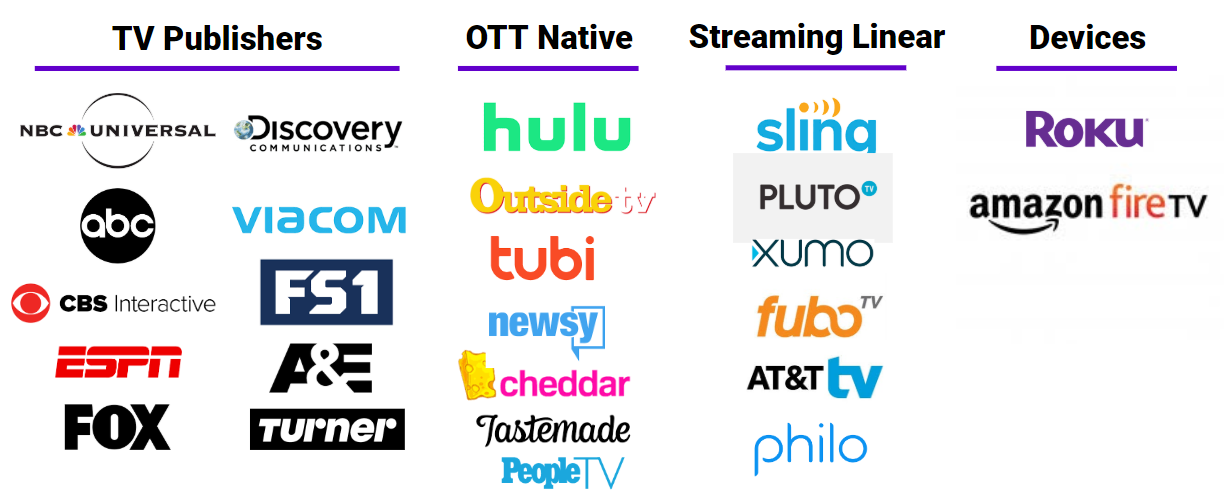
While we won’t mention all of the platforms in this article, we’ll briefly dive into some of the more popular OTT channels and streaming devices that you’ve probably heard of, which include:
Roku is unique in that it is both a streaming device and platform. In 2023, Roku reported a total of 71.6 million monthly active users in the United States. Not only is Roku popular with cord-cutters, but it’s also considered one of the pioneers and leaders in OTT advertising.
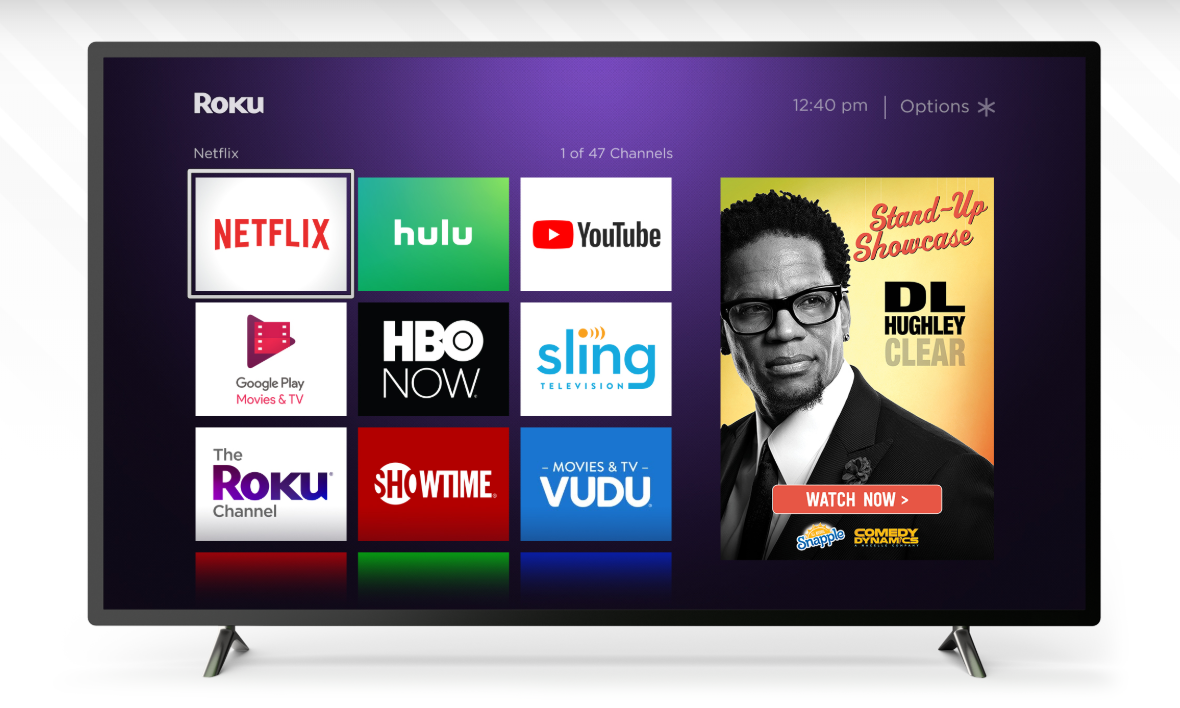
Roku’s native ad platform offers 15 and 30-second ad spots in addition to interactive video, overlays, and sponsorships.
Hulu’s on-demand streaming service has over 48.3 million subscribers as of 2023.
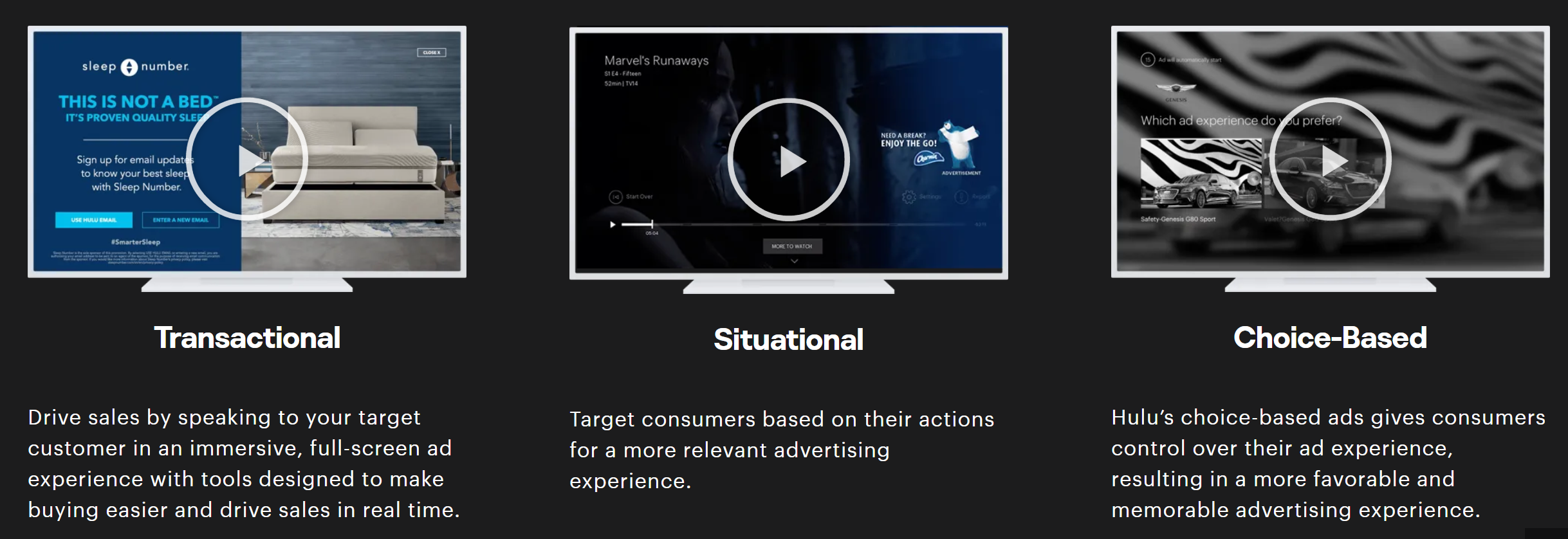
Like Roku, Hulu’s ad platform includes a robust set of options for bidding, targeting, measuring, as well as different ad types.
Sling TV is a live TV streaming service that started in February 2015 – the first such service in the world. With it, viewers can use their tablets, phones, and computers to watch the same live and on-demand programs that would normally be limited to cable and satellite TV. As of 2023, it’s reported to have about 2 million subscribers.
Sling TV’s advertising model combines elements from traditional cable TV and that of more modern digital marketing techniques. Like traditional cable TV, brands are charged by impression and they can choose to advertise on a range of different networks with different content. Also, ads are not skippable, and cannot be fast-forwarded or blocked.
But Sling TV also makes use of programmatic advertising, which allows brands to bid on desirable TV inventory in private auctions. This inventory is divided into live, linear, and on-demand programming.
Not far behind Hulu is another major OTT channel: Tubi TV. With over 74 million monthly active users (worldwide) and content rights that span over 250 partners, Tubi’s ad platform offers 15 and 30-second ad spots that are non-skippable.
Tubi is one of the last remaining truly free OTT platforms, supporting themselves entirely on ad breaks. This business model is clearly working for them – in 2020, they only had 33 million monthly active users, meaning their viewership has more than doubled in a 3-year period.
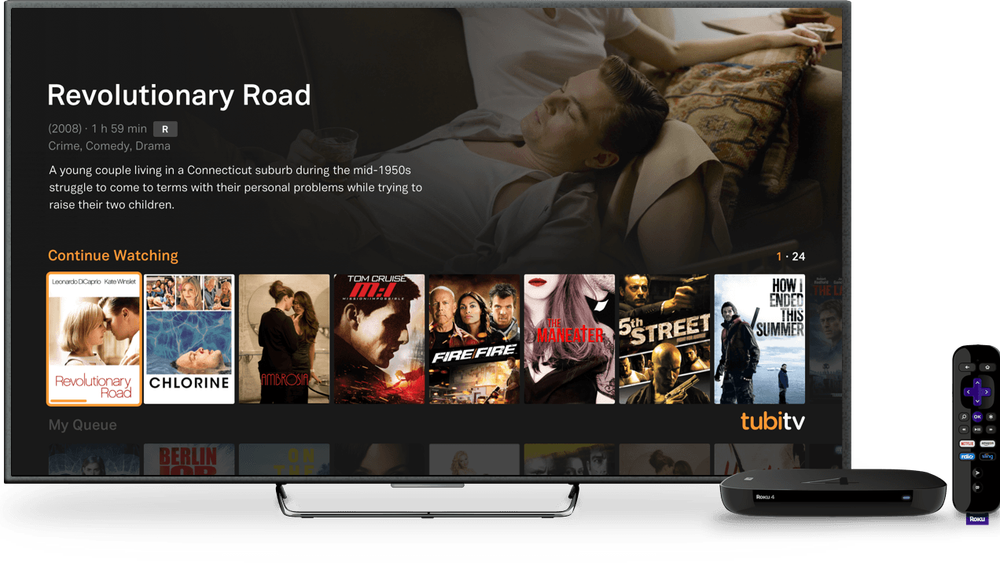
Accessing OTT ads can also be complicated for newcomers, simply due to the fragmentation of platforms and the many different business models that distribute inventory.
In general, there are two ways brands buy OTT advertising: Guaranteed IOs (insertion orders) and Programmatic.
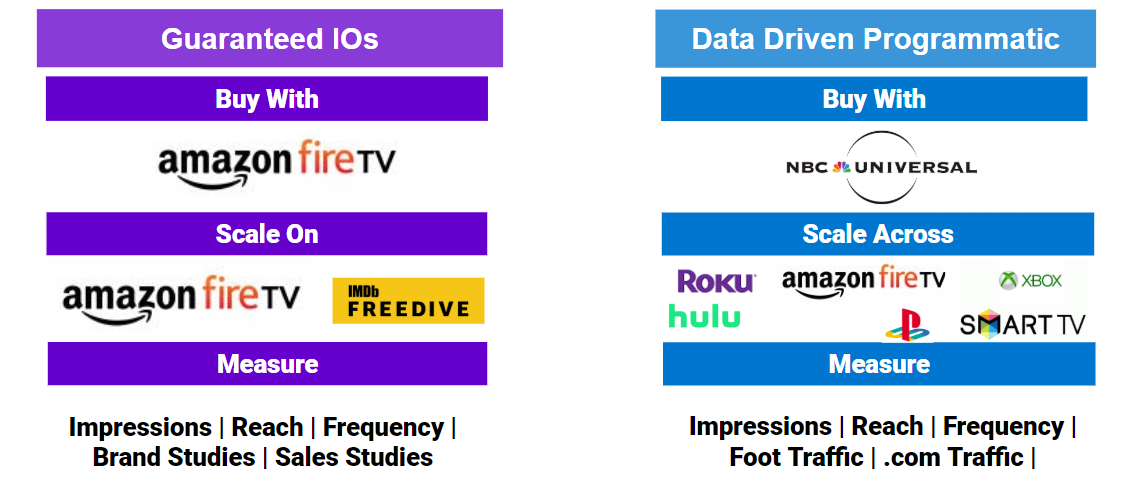
Breadth vs Depth: there are trade-offs to different OTT purchasing models.
Guaranteed IO (insertion orders) buys are set-priced, set impressions, usually based on reach and frequency.
Data-Driven Programmatic buys are based on a real-time bidding environment that allows the advertiser and the agency to maintain control of targeting but does not guarantee set impressions or frequency.
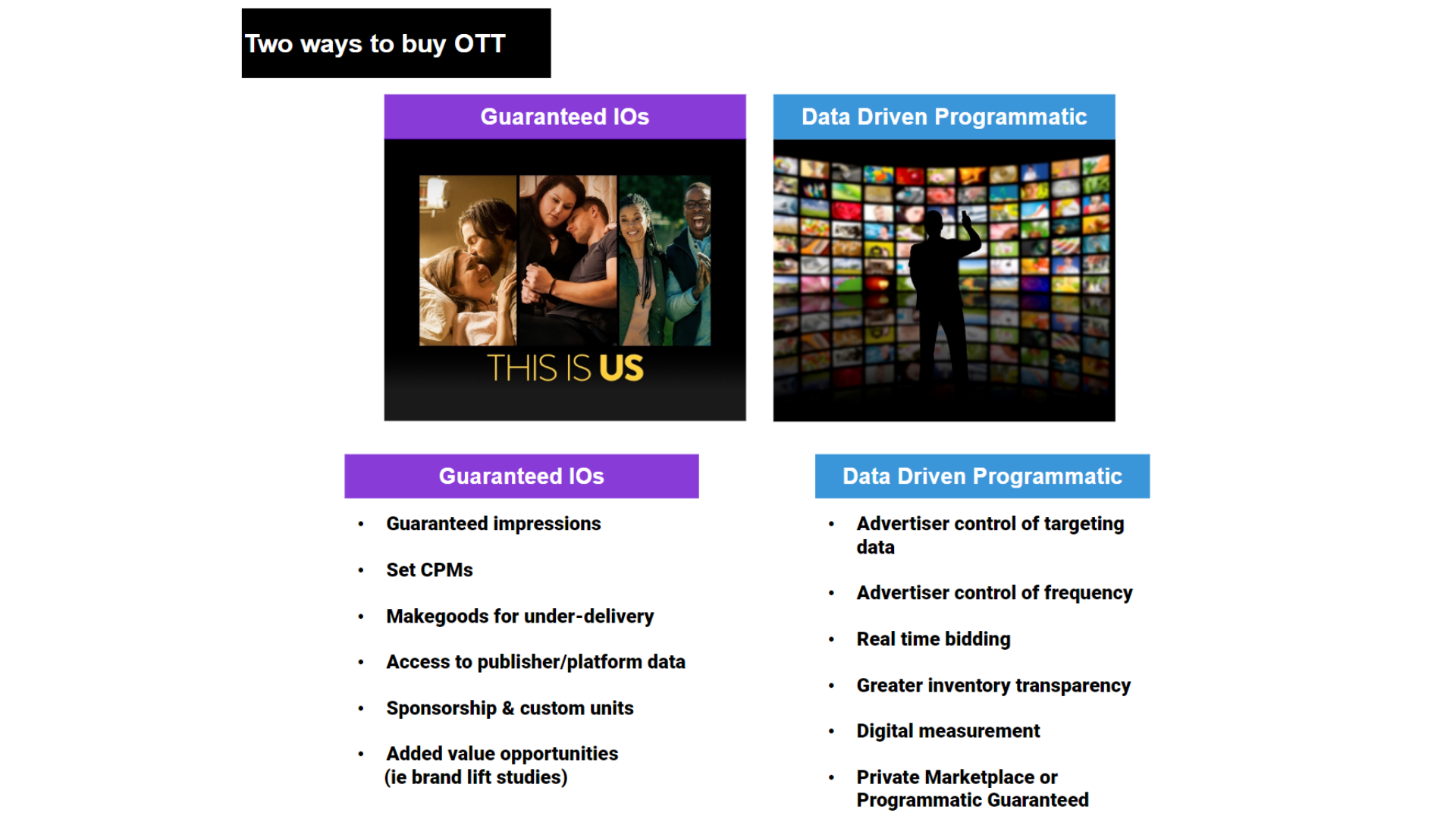
An important consideration for buying over the top inventory is what distinguishes as open versus closed ecosystems.
When you buy through Amazon OTT, for example you get access to all OTT inventory served through Amazon devices.
Open ecosystems, such as NBC Universal, enable brands to access inventory across multiple publishers.
When planning your OTT buying strategy, the conversation is about open ecosystems versus closed ecosystems. Amazon is a closed ecosystem in terms of inventory, measurement, data, and buying entry points. For some brand initiatives, it might make sense to work within a closed ecosystem such as Amazon or Google to access their data and measurement. However, for others, it might make sense to buy programmatically from Universal to access inventory and reach audiences across multiple devices and channels.
The truth is that there’s no one platform that sells everything. Ad inventory in any given hour can be split among several publishers, which is why it can be difficult to stay close to your audience if your inventory is consolidated with a single publisher. There are trade-offs with each.
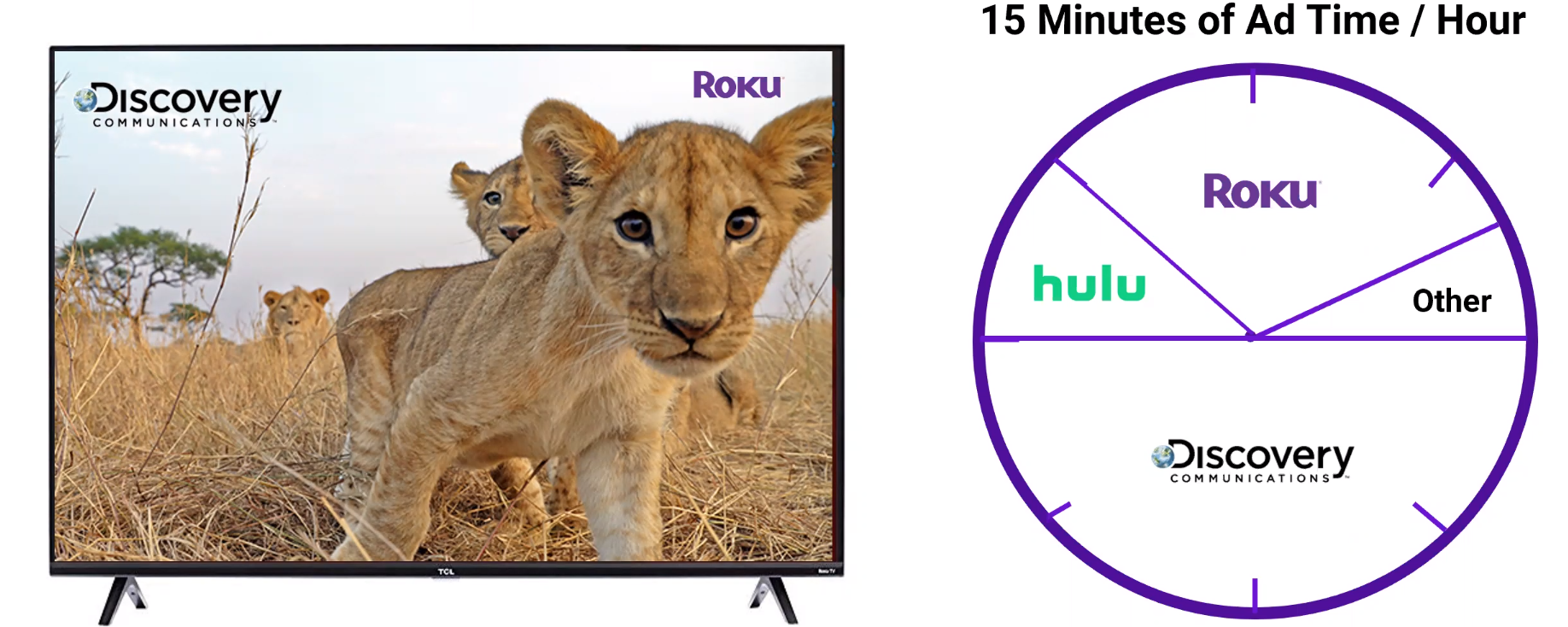
OTT video ads on a given channel can be split between multiple publishers in a single hour-long segment, which is why it can be beneficial to diversify your OTT across multiple services to ensure your message is reaching your audience.
OTT ads are essentially video ads, but for a much more advanced audience. OTT audiences expect top-notch ad experiences.
Here are a few best practices to consider when creating and deploying your OTT ads.
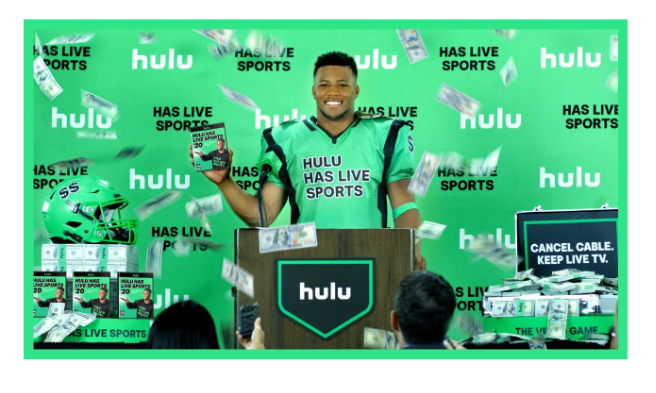
When OTT ads are inserted into video segments, they can appear across multiple device types. Don’t assume that your ads will fit on a large screen TV. Identify sizing best practices so that your value proposition and call to action is immediately apparent on all screen types.
While you may want your ad to evoke the high-quality of a premium television channel placement, don’t fall into the trap of making it as long. Remember, OTT viewers have different expectations when it comes to streaming content. Keep it short and to the point (think 15 to 30 seconds) for non-skippables.
The look, sound, and feel of your videos should reflect that of where your audience is. This can include the day of the week, time of the day, geo-location, weather, and behavior signals. All of these can be combined to inform the creative of your OTT content.
Like any digital channel, a measurement plan is key to determining the success of your investments, which means you need to take various KPIs into account.
The nature of OTT viewing means that most ads aren’t clickable; however. That means that tracking these metrics often requires a third-party attribution solution. This can mean working with a company such as Nielsen or Oracle to track device IDs and across platforms as well as offline touchpoints (such as entering a physical location, like a store)
Beyond being a very fragmented landscape with competing business models, OTT is still a channel with inherent challenges for any brand looking to make the leap to the big screen.
The number one way brands access OTT inventory is through a reseller or an aggregator. Unfortunately, this means that many brands are losing out on transparency because it’s difficult to determine whether their ads are showing on premium channels or less-than-popular segments. By using an OTT agency like Tinuiti, on the other hand, brands have more control, transparency, and access to data with first-party OTT publisher partnerships.
At Tinuiti, we own and operate all of our deals directly with virtually every TV and OTT publisher and platform. This gives us—and you—full transparency into each dollar spent, and the ability to granularly optimize for performance.
Because OTT campaigns are delivered via television, there are challenges when it comes to attribution tracking. Unlike other digital channels, tracking clicks or in-store traffic isn’t as straightforward and can require a third-party to understand the full impact of your OTT ads.
Tinuiti’s OTT partnerships and technology ensure that you are tracking post-OTT exposure in terms of digital performance (such as website visits and conversions) as well as offline impact (such as brick and mortar visitation).
Whether you’re looking to measure visits and sales on your website, foot traffic to your stores, brand lift, or something else, it’s not a question of if OTT will work for you, but how.
Buying OTT media is one thing, but understanding how your OTT campaigns fit into your larger media mix to impact your audience’s decisions requires a sophisticated strategy helmed by subject matter experts.
The real magic of our OTT program lies in our strategic cross-channel approach, which unifies your data strategy with sequential messaging across your media mix. This cross-channel strategy enables a unified audience experience across all channels and screens, and a sequential retargeting strategy that surrounds the consumer and drives conversion.
OTT advertising campaigns can significantly influence your overall marketing effectiveness. Let’s dive into two success stories from Tinuiti: Avocados From Mexico and OLLY.
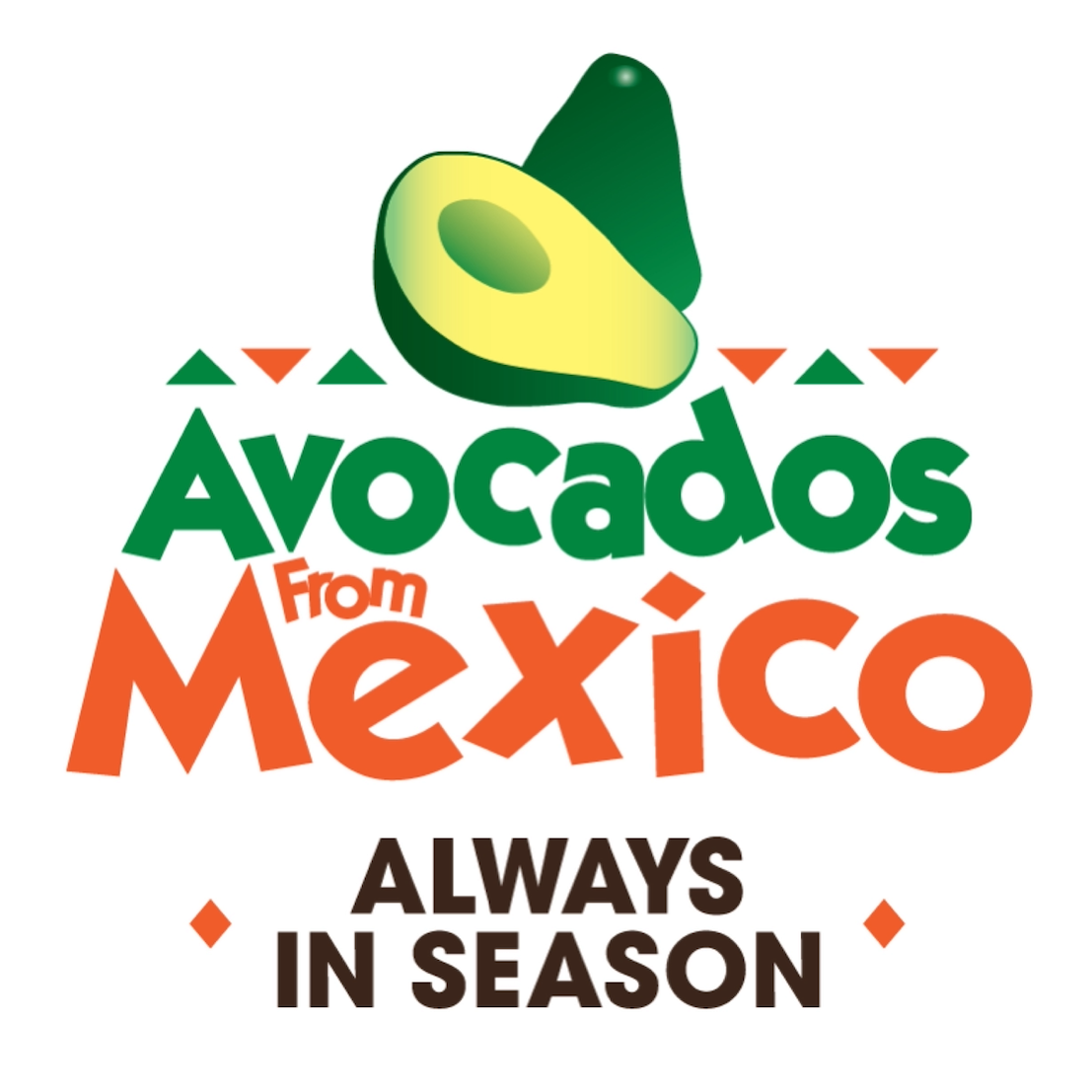
Avocados from Mexico know a thing or two about Super Bowl snacks. In the two months leading up to the Super Bowl in 2020, Avocados from Mexico put 240 million pounds of avocado out into the market — the equivalent of a football stadium covered with 30 feet of guacamole or the amount of guacamole consumed during the Super Bowl.
Super Bowl advertising has done wonders for Avocados from Mexico’s brand. From 2016 to 2021, their brand recognition rose from 23% to 55%, and they’ve been the only brand in the history of the Super Bowl to be in the top one and top two places as a top digital performer among all of the brands that participated in the Super Bowl.
“We think that the worst thing that we can do as an organization is to just continue to do things just because we have done it in the past. So we say, let’s try other things, let’s try other avenues. Let’s reinvent ourselves and discover other territories,” Ivonne Kinser, Head of Digital Marketing and eCommerce for Avocados from Mexico says.
“Based on our experience, our most disruptive campaigns have been those that overlap two or more different technologies. And I think the reason why technology, innovation, disruption is moving today at a much faster pace than it did in the past is because of that. Because there are more technologies and because marketers are discovering different ways to bring those together,” Kinser says.
One recent example of disruptive ad technology? OTT advertising. Kinser explains that she sees over-the-top (OTT) advertising technology as an evolution of traditional advertising and a great opportunity to personalize the ad experience for consumers.
“We can now target households based on the consumption habits of that specific household,” Kinser says, noting that personalization is more important than ever before — and first-party data lets advertisers use OTT to create more personalized ad experiences,” she says.

OLLY partnered with the Tinuiti team to bring their latest campaign to life and to drive brand awareness while eliminating the shame around taboo topics like gynecological well-being.
After brainstorming with the OLLY team and getting inspiration for the amazing creative—Tinuiti strategically selected a multitude of partners to help get the masses ‘Lovin’ Their Libido.’
The media mix included wide-reach OTT activations such as Amazon Fire TV and Hulu, Audio spots with Stitcher/Pandora and Spotify, Digital Out-of-Home (DOOH) placements, YouTube, custom content through partnerships with Healthline and Bustle, such as sponsored editorials and an interactive quiz, and even flashy High-Impact Display activations through Big Happy.
“Despite being relatively new to the OLLY business, Tinuiti brought innovative ideas and a unique approach to this campaign that showed us that they truly understood our target market and OLLY’s values.” -Emily Zwerner, Sr. Marketing Director, OLLY
Want to learn more about the campaign results? Check out the full case study here.
OTT is disrupting the industry for good. As traditional TV continues to lose viewers, more consumers will use streaming apps and ad-supported OTT services like Hulu, Sling, and Pluto. By adding this new channel to your media mix, you have an unprecedented opportunity to target new audiences in new ways — and to do so ahead of competitors who aren’t as ad-savvy.
As OTT viewership continues to explode, so will the opportunities for brands adopting OTT video to support their sales and marketing goals.
If you want to learn more, get in touch with one of Tinuiti’s OTT experts here.
Editor’s Note: This post was originally published in March 2020 and has been updated for freshness, accuracy, and comprehensiveness.

Notifications